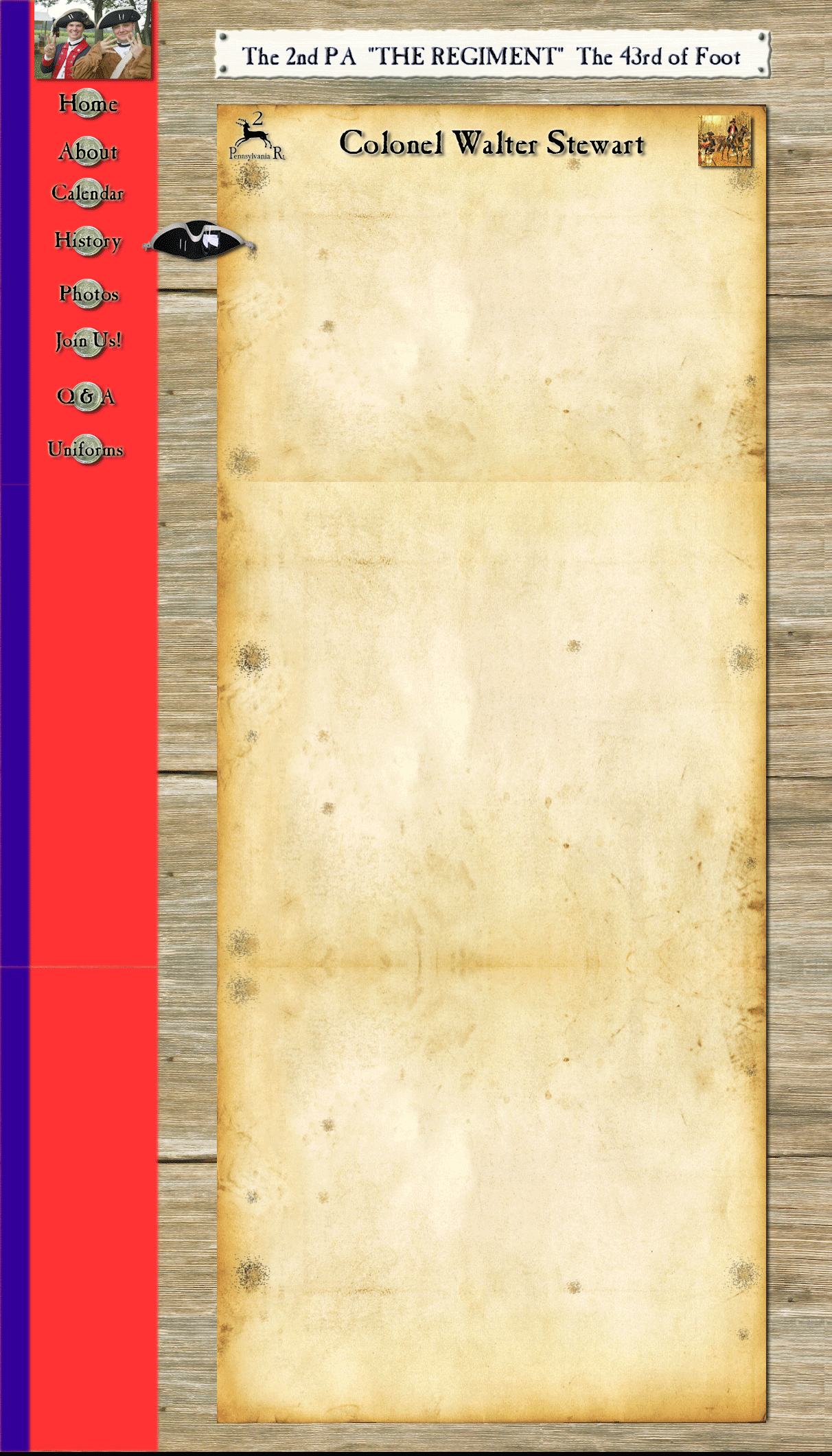
2nd PA History back
COLONEL WALTER STEWART,
COMMANDER OF THE SECOND PENNSYLVANIA REGIMENT
For the last two-and-one-half years of its existence, the Second Pennsylvania Regiment was led by a noted young officer named Walter Stewart. A friend of both common soldiers and patriot leaders such as Anthony Wayne and George Washington, he cut a dashing figure wherever he went.
Born in Ireland in 1756, Stewart began his military career in January, 1776 as a Captain in the Third Pa. Battalion and in May was promoted to Major, serving as aide-de-camp to Gen. Horatio Gates. He was given command of the newly-formed 13th Pa. Regt. ("The Pa. State Regt.") on June 17, 1777. Under his leadership, the unit became one of the state's best, fighting with special distinction at the Battles of Brandywine and Germantown as well as Monmouth in June, 1778, where Stewart was wounded. Shortly afterward the enlistments of many members of the 13th expired so, on July 1, 1778 those remaining with it were merged with the veteran Second Pa. and 22-year-old Stewart was named the unit's commander because of his seniority.
"Custis' Recollections" describes him being "of fair, florid complexion, vivacious, intelligent and well educated and, it was said, was the handsomest man in the American army." In the classic story of the Continental Line soldier, "Private Yankee Doodle," author Joseph Plumb Martin also recalled "the great personal beauty" of Colonel Stewart, saying that "the Philadelphia ladies styled him 'the Irish Beauty.'"
During the mutiny of the Connecticut troops at Morristown in 1780, Martin mentions that Stewart and several other Pennsylvania officers helped defuse the situation by talking with the Connecticut men, explaining they suffered no worse than either the rank-and-file or officers of the rest of the army. Martin added that Stewart then went to speak with the Connecticut officers on behalf of their unhappy enlistees.
"This Colonel Stewart was an excellent officer much beloved and respected by the troops of the Line he belonged to," Martin wrote.
The young regimental commander had a reputation for being concerned with the welfare of his men---a fact illustrated in a letter written to Gen. Wayne when Stewart was in Philadelphia in search of supplies for the Pennsylvanians in November, 1778.
"I find the little necessaries for my regiment difficult to be procured and at the most exorbitant prices, but I am determined to get them and have them I will if possible," he told Wayne.
The handsome young war hero was surely a hit with the ladies of the city during this mission, too. After describing to his friend Wayne that the women "have really got the art of throwing themselves into the most wanton and amorous postures," he confesses: "By heaven tis almost too much for a Healthy, Vigorous, Young Soldier to bear; to be placed on an elegant sofa along Side of one of them, when they are displaying both the artillery of their Tongues and Eyes."
Cupid eventually caught up with the Colonel and on April 11, 1781 (just before starting on the Southern Campaign that would end at Yorktown) he married 17-year-old Deborah McClenachan, oldest daughter of Blair McClenachan who was a prominent and patriotic Philadelphia merchant and one of the founders of the famed First City Troop. Most likely the wedding took place at Cliveden (the "Chew House") in Germantown as Blair had purchased the battle-damaged property from the Chew family in September, 1779, selling it back to Judge Benjamin Chew in April, 1797. It was probably around this time that the couple's individual portraits (and two miniatures) were painted by Charles Wilson Peale, with the Colonel standing full-length in front of a detailed camp scene showing his beloved Pennsylvanians. The sword he holds could be the "$100 sword" Congress gave him in November, 1776.
Eight months and sixteen days after the wedding William, their first child, was born (he would be lost at sea in the summer of 1808 at age 26). The Stewarts would have seven more children (one born in Ireland and another in England) with the last one (named Washington) coming into the world two months and ten days after Walter Stewart's death.
When the Pennsylvania Line was reorganized in January, 1781 Stewart was given command of the Second Division and continued to distinguish himself. He was painted full-length in Trumbull's famous picture of the surrender of Cornwallis on the left of the line of the American officers.
After Yorktown George Washington named him Inspector General of the Northern Department. On January 1, 1783, he retired with the the brevet rank of brigadier general and went on to become a successful Philadelphia merchant and major general of the First Division of Pennsylvania militia. He and Deborah made their home across the street from the Presidential residence of their friends George and Martha Washington, close by Independence Hall. He died at the age of 40 on June 16, 1796 of "bilious fever" (during the city's notorious Yellow Fever epidemic) and was buried with the honors of war in the burial ground of St. Paul's Episcopal Church in Philadelphia.
---Paul Loane

